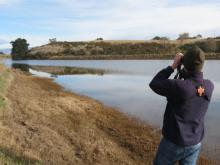Fish & Game Officers Count Shoveler Ducks Nationwide
- 8/08/2016
Fish & Game is mounting a nationwide bird count today – to pin down the number of shoveler ducks found around the country.
 The annual full day survey is carried out every August by officers in all 12 Fish & Game regions, helped by volunteers including Ornithological Society members.
The annual full day survey is carried out every August by officers in all 12 Fish & Game regions, helped by volunteers including Ornithological Society members.
Co-ordinator Senior Fish & Game Officer Matthew McDougall says the survey is now in its 16th year – and is carried out in all regions on the same day to avoid any double-counting, as the birds are quite mobile.
They are counted at this time of year following the hunting season when they are starting to “mob up” as part of their breeding behaviour, he says.
The aim is to monitor any population changes so the Australasian shoveler, commonly known as spoonies for their distinctive flat bill, can be properly managed.
Left: Shoveler sunning themselves at Otipua Wetland.
Fish & Game officers will count shovelers on as many as 260 sites around the country, mostly lowland lakes or wetlands the birds are known to frequent.
Banding has shown the birds are highly mobile and travel large distances. Birds originally banded near Invercargill some years ago were harvested all over the country with one as far north as Kaitaia.
“Last year we counted more than 14,000 shoveler,” Mr McDougall says, “the most at Lake Poukawa in Hawke’s Bay where there’s of the order of 3000 birds.
Fish & Game Officers around the country use pretty simple counting methods, going out in vehicles or even in boats and kayaks armed with binoculars to spot the birds (see photo top right).
“Shoveler like shallow ponds where there are lots of invertebrates to feed on, using their shovel-like bills to sift the aquatic insects from the water.”
Mr Mc Dougall says that most Fish & Game regions have a daily bag limit of two or three birds per hunter and while they are plentiful in some areas, most hunters never get near their limit.
In the South Island, shoveler are a common sight in the Central South Island’s (CSI) coastal wetlands but they are also found in the Mackenzie basin high-country.
CSI Field Officer Rhys Adams says Fish & Game monitoring shows that historically, CSI shoveler populations are healthy (stable), so that the daily bag limit in the region of two birds per hunter per day is sustainable.
They are mainly harvested by the hunters who hunt in the coastal areas but shoveler move around and can pop up at any pond, he says.
He says the birds make up only a minor part of the annual game bird harvest but are “highly prized because they are attractive, taste great and can be hard to hunt with the sometimes erratic way they fly.”
The shoveler is a native species but not endemic to New Zealand.